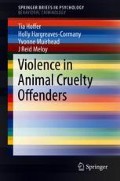Abstract
The discussion section focuses on the conceptualization of animal cruelty and the impact of animal cruelty acts in society. Given that the dog was the most frequently noted animal victim, the development of the relationship between humans and dogs is a significant one. Through the domestication and property status of animals, the relationship with dogs is at times one that indicates some conflict. Are dogs property or members of the family?
The Behavioral Analysis Unit (BAU) study was initiated based on a homicide case and cats that were being eviscerated. The question of the connection between these two acts of violence prompted the idea of examining the criminal histories of animal cruelty offenders for the degree of interpersonal violence. In addition to supporting the link between animal cruelty and interpersonal violence, the study did not obtain results to support the graduation hypothesis, but instead was consistent with the social deviance theory, which notes that individuals who exhibit socially deviant behavior in one area are more likely to commit other deviant behaviors as well.
The discussion section anchored the current study’s results with the research including offender motivation, victim characteristics, the relationship between offender and animal victim, and offense characteristics.
Access this chapter
Tax calculation will be finalised at checkout
Purchases are for personal use only
References
American Pet Products Association’s. (2015–2016). National pet owners survey. http://www.iii.org/fact-statistic/pet-statistics
Arluke, A., Levin, J., Luke, C., & Ascione, F. R. (1999). The relationship of animal abuse to other forms of antisocial behavior. Journal of Interpersonal Violence, 14(9), 963–975.
Ascione, F. R. (1998). Battered women’s reports of their partners’ and their children’s cruelty to animals. Journal of Emotional Abuse, 1(1), 119–133.
Ascione, F. R., Weber, C. V., & Wood, D. S. (1997). The abuse of animals and domestic violence: A national survey of shelters for women who are battered. Society and Animals Journal of Human and Animal Studies, 5(3), 205–218.
Bureau of Justice Statistics. (2005). Family violence statistics including statistics on strangers and acquaintances (NCJ Publication No. 207846). Retrieved from http://www.bjs.gov/content/pub/pdf/fvs.pdf; http://www.bjs.gov/index.cfm?ty=pbdetail&iid=828
De Waal, F. (2016). Are we smart enough to know how smart animals are?. WW Norton & Company. location is New York City, NY.
de Waal, F. B. M. (2012). The antiquity of empathy. Science, 336, 874–876.
DeViney, E., Dickert, J., & Lockwood, R. (1983). The care of pets within child abusing families. International Journal for the Study of Animal Problems, 4(4), 321–329.
Faver, C. A., & Strand, E. B. (2003). Special section: Domestic violence and social work education domestic violence and animal cruelty: Untangling the web of abuse. Journal of Social Work Education, 39(2), 237–253. Retrieved from http://search.proquest.com.proxymu.wrlc.org/docview/209783629/citation/F6FFB111E55A4276PQ/1
Felthous, A. R., & Kellert, S. R. (1986). Violence against animals and people: Is aggression against living creatures generalized? Bulletin of the American Academy of Psychiatry and the Law, 14(1), 55–69.
Flynn, C. P. (2009). Women-battering, pet abuse, and human-animal relationships. In Andrew Linzey (ed.), The Link Between Animal Abuse and Human Violence. Sussex Academic Press. pp. 116–125.
Gullone, E. (2012). Animal cruelty, antisocial behaviour and aggression: More than a link. London: Palgrave Macmillan.
Hoffer, T., & Hargreaves-Cormany, H. (2014, August). Overview of the animal cruelty project: An FBI study. Paper presented at the American Psychological Association Convention, Washington, DC.
Hoffer, T. A., & Hargreaves-Cormany, H. (2017). Animal Cruelty Offenders. In Handbook of Behavioral Criminology (pp. 81–95). Springer, Cham.
Humane Society of the United States. Retrieved from www.humansociety.org/animals/wolves/facts/faq_gra_wolf.html
Ingham, H. R. W., Neumann, D. L., & Waters, A. M. (2015). Empathy-Related Ratings to Still Images of Human and Nonhuman Animal Groups in Negative Contexts Graded for Phylogenetic Similarity. Anthrozoös, 28(1), 113–130.
Kellert, S. R., & Felthous, A. R. (1985). Childhood cruelty toward animals among criminals and noncriminals. Human Relations, 38(12), 1113–1129.
Kempe, C. H., Silverman, F. N., Steele, B. F., Droegemueller, W., & Silver, H. K. (1962). The battered-child syndrome. Jama, 181, 17. Retrieved from http://www.ncbi.nlm.nih.gov/pubmed/14455086
Levitt, L. (2011). The criminal histories of animal cruelty offenders. Available from ProQuest Dissertations and Theses Database.
Levitt, L., Hoffer, T. A., & Loper, A. B. (2016). Criminal histories of a subsample of animal cruelty offenders. Aggression and Violent Behavior, 30, 48–58.
Mead, M. (1964). Cultural factors in the cause and prevention of pathological homicide. Bulletin of the Menninger Clinic, 28(1), 11.
Murrell, A. R., Christoff, K. A., & Henning, K. R. (2007). Characteristics of domestic violence offenders: Associations with childhood exposure to violence. Journal of Family Violence, 22(7), 523–532.
Singer, P. (2011). The expanding circle: Ethics, evolution, and moral progress. Princeton, NJ: Princeton University Press.
Widom, C. S. (1989). The cycle of violence. Science, 244(4901), 160–166.
Author information
Authors and Affiliations
Rights and permissions
Copyright information
© 2018 The Author(s) under exclusive licence to Springer International Publishing AG, part of Springer Nature
About this chapter
Cite this chapter
Hoffer, T., Hargreaves-Cormany, H., Muirhead, Y., Meloy, J.R. (2018). Discussion. In: Violence in Animal Cruelty Offenders. SpringerBriefs in Psychology(). Springer, Cham. https://doi.org/10.1007/978-3-319-91038-3_17
Download citation
DOI: https://doi.org/10.1007/978-3-319-91038-3_17
Published:
Publisher Name: Springer, Cham
Print ISBN: 978-3-319-91037-6
Online ISBN: 978-3-319-91038-3
eBook Packages: Behavioral Science and PsychologyBehavioral Science and Psychology (R0)

